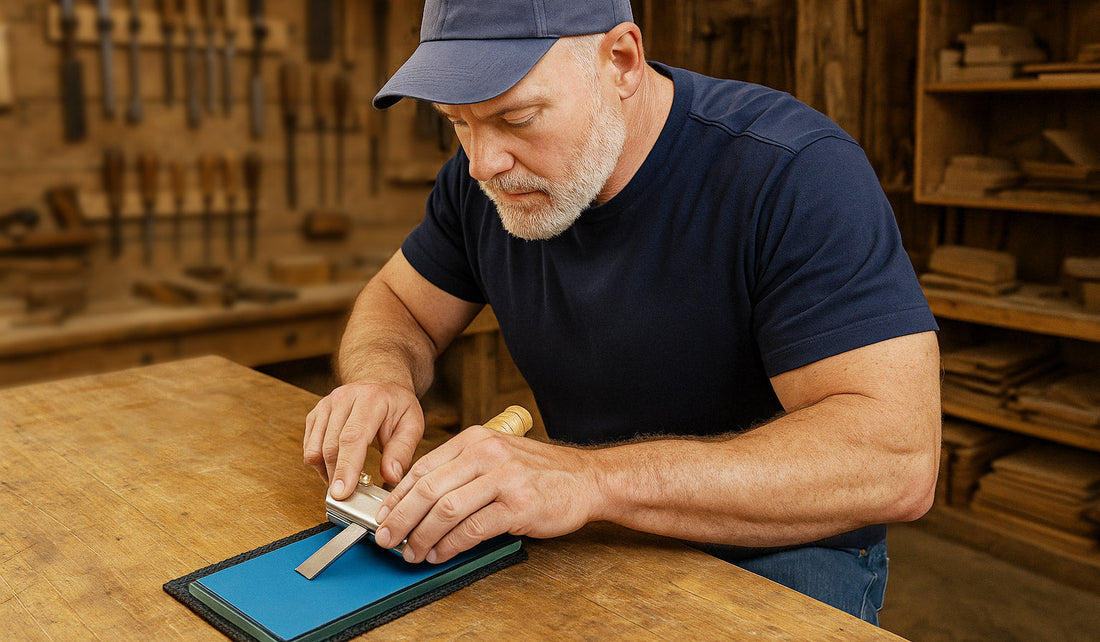
A Beginner’s Guide to the Scary Sharp Method with Lapping Film
Share
There are many ways to sharpen a blade — stones, diamond plates, even powered systems. But one method has become a favorite among both beginners and pros: the Scary Sharp method.
Traditionally, this approach used sandpaper on a flat surface. Today, many sharpeners prefer lapping film instead. It’s cleaner, more consistent, and capable of producing edges so sharp they live up to the name “Scary Sharp.”
So, what Is the Scary Sharp Method?
At its core, the Scary Sharp method is simple: place a sheet of abrasive on a flat surface like glass or granite, and use it to refine your blade. By moving through progressively finer abrasives, the edge becomes sharper and more polished at each stage.
It’s a straightforward, repeatable system that doesn’t require expensive gear — just a flat surface and the right abrasive films.
Why Use Lapping Film Instead of Sandpaper?
Sandpaper works, but it wears out quickly and can be inconsistent. This means it could potentially leave scratches or underperform. Lapping film is typically used in demanding applications and is designed for precision cutting, smoothing and polishing in different industries.
Some of the clear advantages:
-
It stays flat and cuts evenly
-
It lasts longer than ordinary sandpaper
-
It comes in a wide array of grit sizes from aggressive fast cutting to very fine grades for mirror-like finishes
-
It produces a cleaner, more predictable result
For many people, switching to lapping film is the single biggest improvement to the Scary Sharp method.
What You’ll Need
Getting started doesn’t require much:
-
A flat base such as glass, granite, or even steel
-
Sheets of lapping film in a range of abrasives
-
A knife, chisel, or other blade to sharpen
- A small amount of water or a few drops of vegetable oil (optional)
Also optional but helpful: a honing or angle guide.
How to Use the Scary Sharp Method with Lapping Film
1. Set up your base – Place your glass or granite on a stable surface. It is a good idea to use a non-slip mat under glass to keep it from moving.
2. Apply the film – Secure a sheet of abrasive to the base.
3. Sharpen the blade – Hold a steady angle and work the blade back and forth across the film until the edge feels uniform.
4. Work finer – Switch to a smoother film and repeat the process, gradually refining the edge.
5. Polish and finish – Continue until the edge feels sharp and clean, with a bright polished look.
That’s all there is to it. Simple, consistent, and surprisingly effective.
What Can You Sharpen?
The Scary Sharp method with lapping film works on almost anything with an edge:
-
Kitchen knives
-
Chisels and plane irons
-
Carving tools
-
Scissors
- Straight edge razors
Why Scary Sharp Stands Out
The appeal of this method is that it’s:
-
Affordable – You don’t need costly stones or machines
-
Accurate – A flat base ensures consistent results
-
Performance – Produces edges sharp enough for fine woodworking or kitchen prep
The Scary Sharp method has earned its reputation because it’s simple, precise, and powerful. By swapping sandpaper for lapping film, you unlock even greater sharpness and consistency.
With just a piece of glass and a few sheets of lapping film, you can achieve edges that live up to the name: Scary Sharp.
FAQs
1. Can you sharpen kitchen knives with the Scary Sharp method?
Yes. The Scary Sharp method with lapping film is an excellent solution for sharpening kitchen knives, giving them a fine, polished edge that slices cleanly. With sharpening knives, it is recommended to use a base or holder for the glass plate to elevate the sharpening surface. This provides a clearance for the blade handle. Here is an example of scary sharp system for knives - https://sharposharp.com/collections/knife-sharpening-products
2. How long does lapping film last?
Lapping film generally lasts longer than sandpaper. Its lifespan depends on how often you sharpen and what tools you’re working on, and how many grit sizes you're stepping through.
3. Do I need special equipment for the Scary Sharp method?
No. All you need is a flat surface like glass or granite, sheets of lapping film, and the blade you want to sharpen. A honing guide can help with chisels or plane irons, but it isn’t required. Also, some sharpeners like to use a few squirts of water or few drops of vegetable oil to help gather the slurry (metal particles) as the sharpening takes place.
